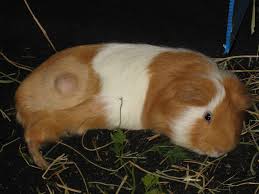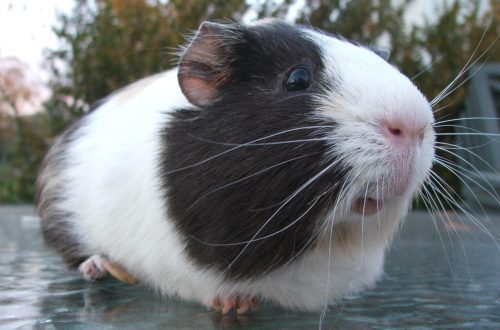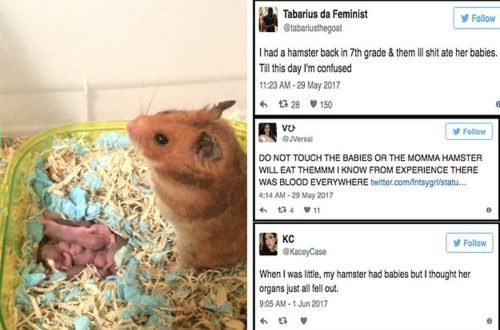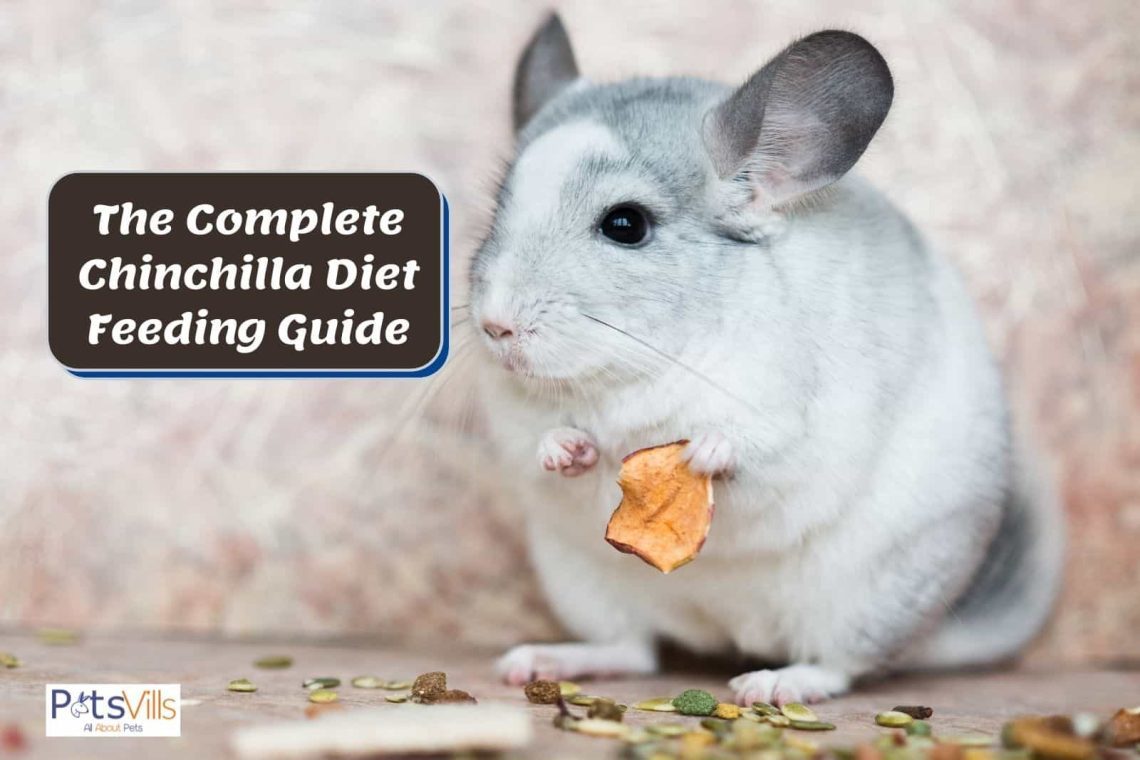
How to feed a chinchilla: a diet at home (table), a list of what can and cannot be given to rodents from food
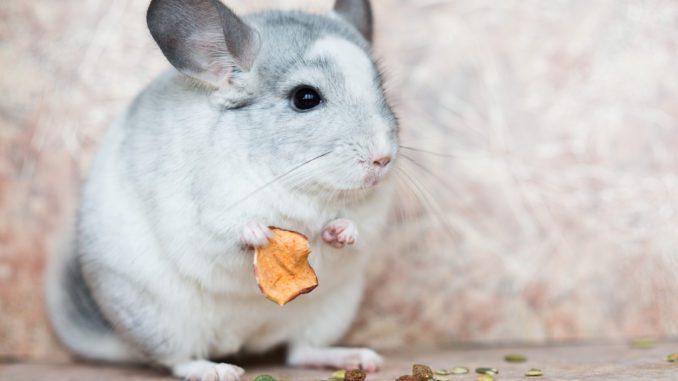
Chinchillas are unusual and quite popular domestic rodents, characterized by excellent health and a long lifespan. Feeding chinchillas at home is a difficult and very important issue, especially for beginner chinchilla breeders. Improper feeding negatively affects reproductive function, the appearance of expensive fur and the general health of animals, sometimes nutritional errors cause the death of furry animals.
Before you start an exotic rodent, you need to thoroughly understand how to feed a chinchilla at home, what foods should form the basis of the animal’s diet, what you can and cannot treat your beloved pet to.
Contents
- What do chinchillas eat?
- The diet of domestic chinchillas
- Balance of fats, proteins and carbohydrates
- Balance of vitamins and minerals
- How to feed a chinchilla: feed features
- Concentrated feed
- Grain mixtures
- Hay
- Drinking water
- dried herbs
- Branches and leaves of trees
- Berries, nuts, vegetables and fruits
- Vitamins for chinchillas
- Treats for chinchillas
- What you can and cannot feed a chinchilla
What do chinchillas eat?
In the wild, chinchillas feed on bark, flowers, shrub twigs, and sparse, low-growing plants of the highlands, which is the natural habitat of South American rodents. The nutritional value of mountain grasses is much higher than the usual hay produced for chinchillas. Therefore, the diet of a domestic chinchilla should be more varied and balanced than that of wild animals, and include not only carefully selected grasses and hay, but concentrated feed, fruits, berries and vitamin supplements.
The diet of domestic chinchillas
The diet of pets is as close as possible to the composition and quality of feed that chinchillas eat in nature, given the need of small rodents for proteins, fats, carbohydrates, vitamins and minerals. Failure to comply with the proportions of nutrients, the norm of vitamins and mineral supplements in the diet of chinchillas has an extremely negative effect:
- on the growth and formation of the skeleton of a domestic animal;
- wool quality;
- reproductive, digestive, immune and excretory functions of the body.
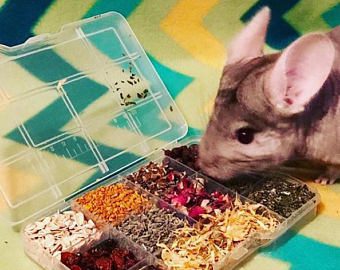
Given the inactivity of pets, you should correctly calculate the amount of food consumed in order to avoid the development of obesity in cute animals. You can feed a chinchilla with a relatively small amount of food, provided it contains all the necessary nutrients, vitamins and trace elements in the required proportions.
At home, it is necessary to use not only hay and combined feeds that chinchillas eat to feed small animals, but also introduce mandatory additional products: fresh and dried herbs, berries and fruits, twigs, vitamin and mineral supplements.
Balance of fats, proteins and carbohydrates
When compiling a daily diet for chinchillas, it is necessary to take into account the daily need of the animal for proteins, fats, carbohydrates as a percentage, season, age and physiological state of the animal.
Proteins necessary for furry rodents to regenerate cells of all animal organ systems. Chinchillas have a relatively low need for proteins and amino acids, during the day you can give chinchillas about 20% of protein feed, which are responsible for the shine and elasticity of chic fur, it can be alfalfa flour or hay, oilseeds, milk, legumes, cereals and nuts . A lactating or pregnant female should consume additional protein foods of animal origin for proper formation of the calf’s organ systems and breastfeeding. These include: cottage cheese, meat and bone meal, milk granules, milk, kefir.
Fats in the diet of pets should be contained in a minimum amount, about 4%, they are responsible for the proper development of small chinchillas, the condition of fluffy fur and skin, and are a source of energy. To meet the need for fats, exotic rodents are introduced to the diet of nuts, cake and oilseeds.
Carbohydrates – a source of energy and the main component in the diet of domestic chinchillas. They account for about 35% of the daily food and 30% of the crude fiber necessary to maintain intestinal motility and excretion of toxins. Feeding chinchillas is based on the use of cereal hay, grains, herbs, vegetables and fruits rich in vegetable fibers with a low content of protein and fat.
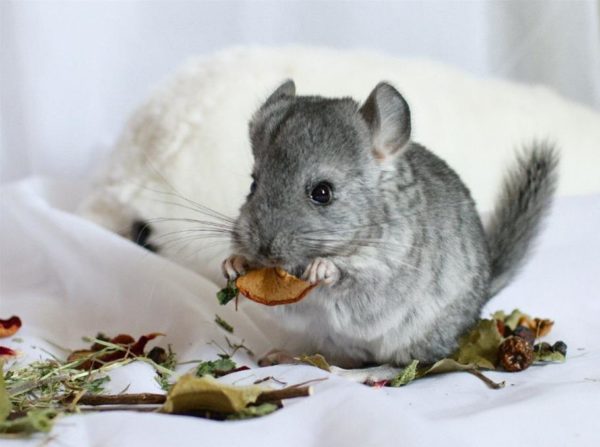
Balance of vitamins and minerals
In addition to food, pets must receive vitamin supplements and mineral supplements. The lack or absence of which negatively affects the formation of the skeleton and muscle tissue of small animals, the quality of the fur and the well-coordinated work of all organ systems of rodents. Vitamin deficiency is often the cause of serious diseases in pets.
Vitamin A (carotene)
Required for:
- proper formation of dental and bone tissue;
- responsible for the work of the organs of vision;
- immune system;
- metabolism;
- skin and fur condition.
The lack of this vitamin in the diet of chinchillas leads to:
- to the deterioration of immunity;
- hair loss;
- decrease in reproductive function;
- frequent incidence of domestic rodents.
To replenish vitamin A, you can feed the chinchilla:
- corn;
- alfalfa;
- carrots;
- pumpkin;
- bananas;
- green salad and spinach.
B vitamins
Thiamine, riboflavin, pantothenic acid, pyridoxine, folic acid are involved in:
- in metabolism;
- the formation of a fatty layer;
- regulate the functioning of the nervous system, liver;
- in the development of a growing organism;
- as a coat.
The lack of these vitamins leads to:
- to impotence and pathologies of pregnancy;
- nervous disorders;
- liver diseases.
It is recommended to add to the main feed that the chinchilla eats:
- germs of oats and wheat;
- oat flakes;
- fresh vegetables and fruits;
- beans, peas, chickpeas;
- bananas;
- slaughter;
- yeast;
- milk;
- by-products;
- coarse flour.
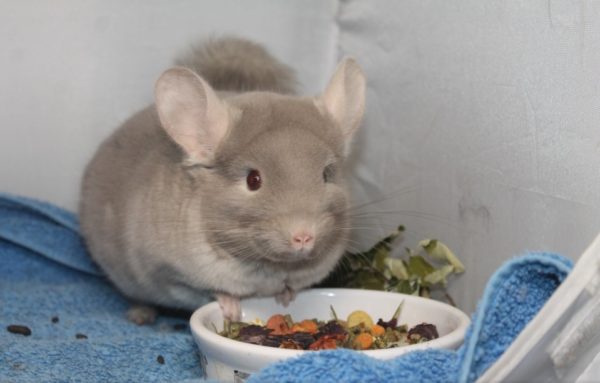
Vitamin C (ascorbic acid)
Required for:
- responsible for the functioning of the immune system;
- blood clotting;
- cell regeneration.
Vitamin deficiency is manifested by a decrease in the resistance of animals to diseases. To meet the needs of the animal in ascorbic acid, you can give the chinchilla:
- parsley greens;
- sorrel;
- rose hips;
- potatoes.
Vitamin E (tocopherol)
Responsible for the functioning of the immune and reproductive systems. Lack of tocopherol leads to:
- aspermia;
- impotence;
- pathological pregnancy and childbirth;
- congenital diseases of newborn puppies.
Vitamin E is found in:
- almond;
- celery
- parsley;
- corn;
- walnuts.
Minerals
Calcium, phosphorus and potassium are involved in:
- in metabolism;
- building bone and dental tissue;
- are responsible for the work of the immune, protective, nervous and cardiovascular systems.
The lack of minerals is manifested by rickets of young animals and diseases of chinchillas.
Minerals contain:
- bone flour;
- parsley greens;
- dandelion;
- celery
- apples;
- wheat;
- beans;
- beans.
Trace Elements
The body of a chinchilla needs sulfur, copper, iron, cobalt, magnesium, zinc, the lack of which is manifested:
- anemia;
- loss and deterioration of the quality of wool;
- nervous disorders;
- decrease in reproductive function.
To fill the need for trace elements, a rodent can eat:
- bran;
- wheat and oat sprouts;
- oat flakes;
- various greens;
- nuts.
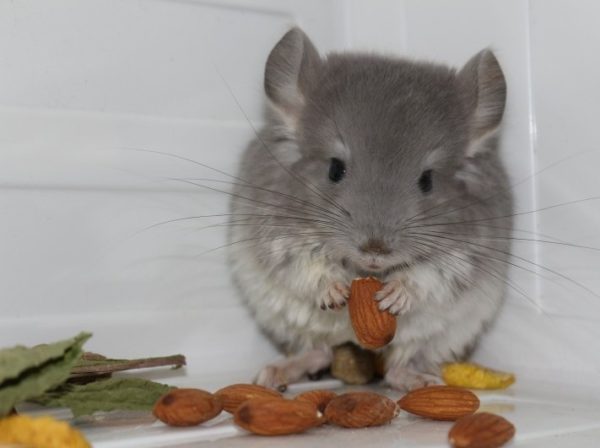
A good option is the use of vitamin supplements and mineral supplements designed for chinchillas, taking into account the daily needs of the animal.
Some owners believe that everything that intelligent rodents eat cannot be harmful to the chinchilla’s body, and fluffy animals are able to independently determine harmful and healthy foods. This insidious delusion sometimes turns into the death of pets as a result of eating prohibited foods.
How to feed a chinchilla: feed features
Particular attention must be paid to the quality of the feed used.
Do not feed your chinchilla spoiled food, wet or moldy hay or grass. Such food causes disorder and inflammation of the gastrointestinal tract, and often the sudden death of a pet as a result of bloating of the stomach or intestines.
If you run out of food for chinchillas or special hay, you can feed the animal with berries, vegetables, fruits, self-collected and carefully prepared herbs.
The pet menu should consist of the following main ingredients:
- Basis: homemade concentrated food or factory-made special food for chinchillas, hay and drinking water.
- Vegetable dressings are used in doses: green fresh and dried herbs, berries, fruits, wheat and oat sprouts.
- Treats are used in minimal quantities to encourage small rodents during training or treats to a furry friend: nuts, corn rings, dried fruits.
- Vitamin and mineral supplements.
- In the pet’s cage all day long there should be clean water, concentrated ready-made food and fresh high-quality hay, which is given to healthy animals in unlimited quantities.
Concentrated feed
Concentrated food is the basis of the diet for small rodents, combining high nutritional value with a minimum content of fat and sugar. Concentrated feeds include legumes and grains, oilseeds. The ideal option is to use in the diet of chinchillas high-quality ready-made granulated feed from well-known manufacturers Versele Laga Chinchilla & Degu Pro, Vitakraft Vita Special, Vitakraft Pellet, designed specifically for chinchillas, taking into account the physiological needs of rodents for nutrients. An adult eats about 1 kg of granular feed per month.
Granules are prepared according to a carefully verified recipe and contain the required amount of proteins, fats, carbohydrates, vitamins and minerals, food is produced taking into account the age and physiological state of small pets.
When using only purchased or self-made grain mixtures without the introduction of granular feed, the animals sort out the grains and do not eat all the ingredients, which leads to a lack of nutrients in the pet’s body.
Granular feed is recommended to be poured into feeders at the rate of 25-30 g per day per adult. When spilling or throwing away food, it is recommended to reduce the number of sweets fed, do not pour a new portion until the previous food has been eaten.
Grain mixtures
Grain mixtures are a very important component of the diet of domestic chinchillas, saturating the body of animals with vitamins, minerals, fats and proteins. Fluffy pets are recommended to introduce the following cereals and seeds into the diet:
- error – a complex carbohydrate that gives a long saturation of the animal’s body, contains iron, protein, vitamins B and P, calcium, phosphorus and iodine;
- wheat – is a source of vegetable proteins and carbohydrates with a low content of fats, trace elements, B vitamins, fiber, which stimulates intestinal motility. The use of wheat is important for lactating female chinchillas, who require increased care and recuperation after childbirth;
- pearl barley – made from barley, rich in a huge amount of useful macro- and microelements (potassium, calcium, phosphorus, copper, zinc, manganese, iron, chromium, cobalt) and vitamins A, D, E and group B, necessary for the functioning of the nervous system, maintaining the beauty of chic chinchilla fur and leather;
- corn – contains amino acids and vitamins necessary for the rodent’s body, which are involved in the pet’s metabolism;
- oats or oats – a healthy nutritious cereal rich in vitamins A, B, E, amino acids and carbohydrates, helps to remove toxins from the body of rodents, it is recommended for pregnant, lactating females and puppies;
- flax seed – contain vitamins A, B, E and Omega-3 acid, necessary for the reproductive function of pets and maintaining the immune system, seed husks are an excellent tool for removing toxins from the body;
- sunflower and pumpkin seeds – rich in fats, protein and vitamins, used in a minimal amount to prevent pet obesity.
It is advisable to feed chinchillas not with one type of grain, but with a grain mixture. It is allowed to cook cereals from cereals – oatmeal, corn, buckwheat and millet, which are especially useful for feeding young animals.
Hay
Hay is an important part of the furry animal’s diet, which should be available to the chinchilla every day. It is best to buy hay for exotic rodents in specialized stores, the following brands have successfully proven themselves: Prestige, Fiori, Medow Hay, Biokraft.
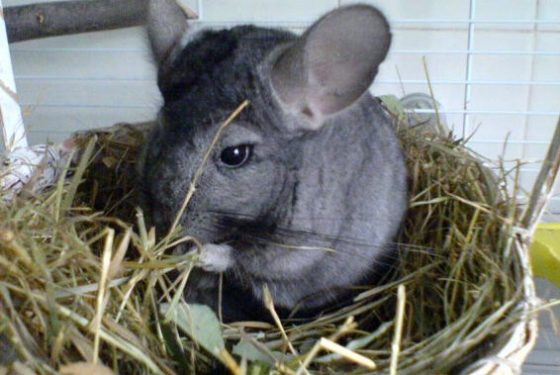
For chinchillas, hay is best, consisting of alfalfa, vetch, clover, legumes contain a sufficient amount of protein, calcium, phosphorus and vitamins. The animal also feeds well on mixed grass or cereal hay, which is slightly inferior in nutritional value to bean hay.
Hay should be dark green, uniform, fresh with a pleasant smell, free of dust or mold, wet or spoiled grass should not be given to the chinchilla.
Hay is necessary for rodents to improve intestinal motility in order to avoid stagnation and fermentation processes in the gastrointestinal tract, as well as to prevent the formation of hooks on the teeth. Hay is given to animals in small portions to avoid contamination. If the rodent scatters grass around the cage, it is recommended not to give hay for several days.
It is highly discouraged to use hay as a bedding, a wet product is dangerous as a manifestation of intestinal disorders and deaths.
If the hay is dirty, wet or dark, you must immediately remove the spoiled product from the cage. If the hay remains in the cage the next day, it is also discarded.
An alternative option is to make your own hay with careful selection of herbs. Crow’s eye, poisonous ranunculus, dope, white hellebore can cause the death of a little friend. It is necessary to mow the young grass to the stage of spikelet appearance and dry it in a dark, well-ventilated area to avoid molding of the product. It is recommended to store the self-prepared product in a dry place by placing hay in linen bags or cardboard boxes.
Drinking water
At home, chinchillas drink from nipple drinkers suspended from the wall of a cage or aviary. Do not pour water into open containers to avoid rapid contamination and overturning of dishes.
For fluffy rodents, bottled non-carbonated baby water or purified with a carbon filter is used; it is highly recommended not to give small pets raw water from the tap to avoid intestinal disorders.
It is recommended to change clean drinking water once a day. 2 times a week, it is necessary to wash off the mucus from the inner wall of the drinking device, treat the spout and the cavity of the drinker with boiling water.
dried herbs
Vegetable top dressings are given in very limited quantities, no more than 4-10 g per day. These include dry herbs and leaves, branch fodder, dried berries and fruits, cereal sprouts.
Green food is introduced gradually with a daily increase in the dose, feeding with herbal supplements has a positive effect on the development of young chinchillas.
Starting in spring, you can treat small pets with a small amount of well-dried green herbs rich in vitamins and trace elements. As a green bait use:
- dandelion grass;
- horse sorrel;
- plantain;
- yarrow;
- nettles;
- burdock;
- alfalfa;
- crow’s feet;
- clover;
- parsley;
- salad dressing;
- spinach;
- tops of carrots;
- chicory;
- strawberry, strawberry and raspberry leaves.
Dill should not be fed to small pets, dill or fennel seeds are great for bloating the intestines or stomach in chinchillas.
It is very useful to feed rodents with barley or wheat sprouts rich in vitamin E.
Sprouted grain is given to pregnant females daily for the successful course of pregnancy and the proper development of the cubs.
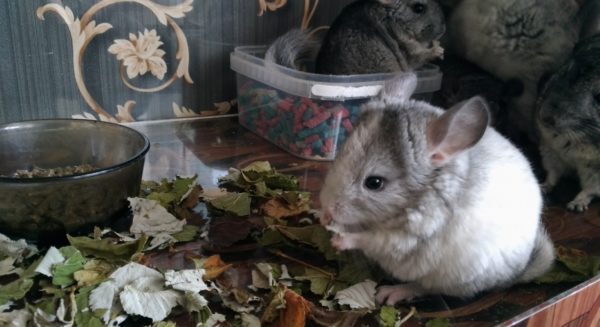
Branches and leaves of trees
Branch food must be present in the diet of fluffy pets. It is necessary for the proper grinding of teeth and a source of vitamins and microelements; dried tree leaves are also readily eaten by exotic rodents. For chinchillas, branches of the following trees are harvested.
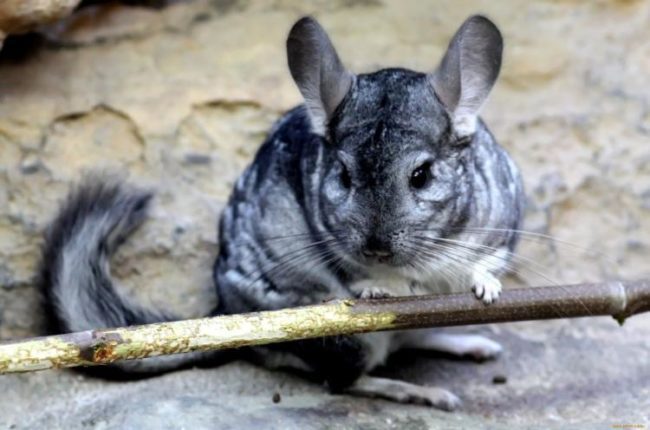
Birch
Birch branches contain vitamins, carbohydrates and phytoncides, dried young leaves are a source of vitamin C.
Oak
The fruits of the oak branch have an astringent effect and are a highly nutritious food.
Willow
It is advisable to feed chinchillas with nutritious willow branches cut in winter.
Aspen
For food, bark, leaves and young shoots are used, which can be given to animals all year round.
Juniper
Chinchillas are happy to feast on needles and berries of a useful shrub.
Pine
Pine branches are cleaned of resin before feeding to pets, rodents also willingly feast on pine cones.
Bark and branches of fruit trees
Pears, apple trees, sea buckthorn are also actively used as branch fodder.
It is forbidden to use for feeding chinchillas branches of apricot, almond, elderberry and bird cherry, containing substances toxic to pets.
Berries, nuts, vegetables and fruits
Juicy food is a source of vitamins, microelements and fiber necessary for the well-coordinated work of the gastrointestinal tract. Chinchillas willingly eat delicious fruits, the owners need to accurately dose the feed in order to avoid the development of allergies and intestinal disorders.
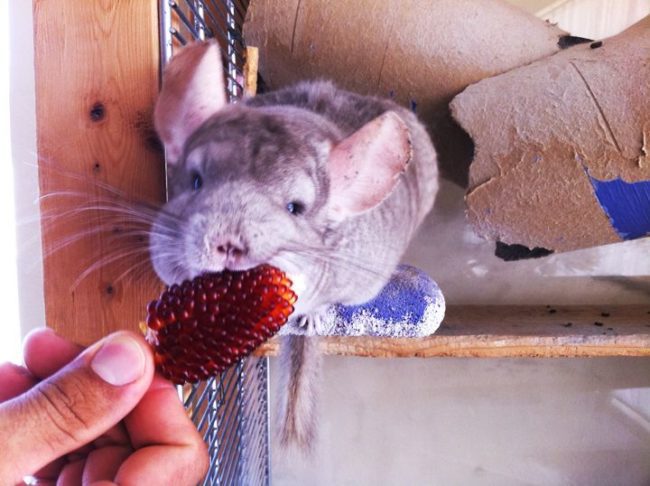
Pets are dosed with treats:
- carrot;
- bananas;
- fresh apples and pears;
- grapes;
- wild rose;
- figs;
- mango;
- Jerusalem artichoke;
- zucchini;
- tomatoes;
- apricots;
- strawberries
- blueberries;
- strawberries.
It is forbidden to feed small animals with fresh cabbage, persimmons, beets, oranges, fresh cucumbers. Also, rodents should not eat food from the human table: cheese, smoked meats, honey, sweets, bread.
Dried fruits contain a lot of sugar in a small piece of the product, so it is recommended to use them no more than once a week in minimal quantities. Chinchillas can be treated:
- dried apricots;
- raisins;
- prunes;
- dates;
- dried apples.
Nuts contain a lot of protein and fat, so they can be fed to a small pet in crushed form in an amount of no more than 2 pieces per week. Chinchillas are given raw:
- hazelnut;
- peanut;
- almond;
- Walnut.
Pine nuts and apricot kernels are not recommended for pet feeding.
Vitamins for chinchillas
Chinchillas need vitamin supplements regardless of the presence of vitamin feeds in their diet. Ready granular feed contains vitamins and minerals. Therefore, the daily norm of a rodent when using ready-made feeds can be halved.
Vitamin supplements must be purchased in specialized stores. Trademark preparations have successfully proven themselves:
- Multi tabs;
- Canine Petvital N 200;
- life vitamins;
- Phytomins;
- Vitamin Cal.
Vitamin supplements are available as solutions, tablets, or powders. Liquid preparations can be dripped onto the animal’s favorite delicacies, tablet forms are hidden in a raisin, pieces of dried fruits are rolled in powders.
Treats for chinchillas
As a treat for encouragement, you can use what chinchillas love most from food: dried fruits, nuts, berries, fruits, oats, sunflower seeds and pumpkins. You can treat the animal with a scanty amount and monitor the reaction. With the manifestation of intestinal disorders or hair loss, it is worth canceling delicious food.
You can buy special treats for exotic rodents of the brands Gryzunchik, Vitacraft and Life in specialized stores in the form of cookies, sticks, biscuits, rings, which should be used exclusively as a treat for your favorite animal.
Overfeeding a rodent with delicacies leads to obesity of a pet.
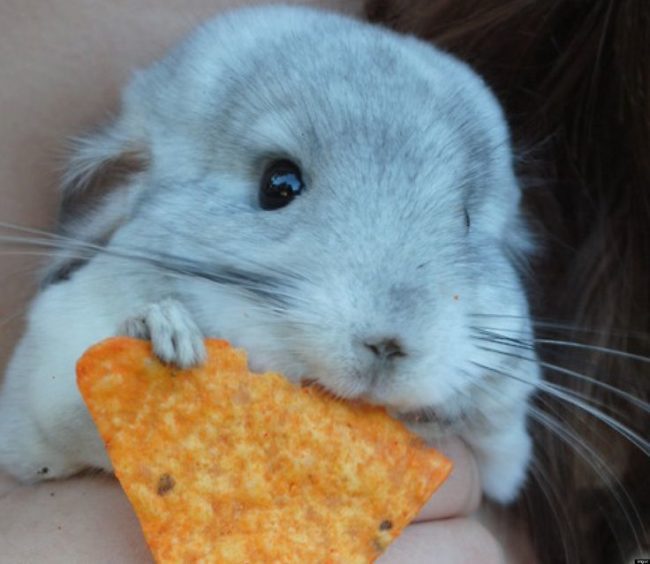
What you can and cannot feed a chinchilla
Inexperienced chinchilla breeders often make stupid mistakes when treating their favorite animals with pine nuts, chips or tangerines. As a result, absolutely bald animals with severe allergies are brought to veterinarians, sometimes nutritional errors cause the death of a pet. Chinchillas can be fed pellets, hay and water. All other products must be strictly dosed. We recommend that you familiarize yourself with the list of products that can and cannot be used to feed your little friend.
Table of allowed and prohibited products
| Product | Can be done in small quantities | Must not |
| Grains and cereals | corn | rye |
| soy | ||
| rice | ||
| error | ||
| millet | ||
| oat | ||
| wheat | ||
| barley | ||
| beans | ||
| broad beans | ||
| peas | ||
| Greens and leaves | dandelion | crow’s eye |
| horse sorrel | ranunculus poisonous | |
| plantain | dope | |
| nettle | hellebore white | |
| clover | May lily of the valley | |
| goose cinquefoil | spurge | |
| alfalfa | digitalis | |
| burdock | Kaluzhnitsa | |
| parsley | fern | |
| salad | Highlander | |
| spinach | field mustard | |
| raspberry leaves | vivacity | |
| strawberry leaves | marsh marigold | |
| Yarrow | lumbago | |
| strawberry leaves | hemlock spotted | |
| chicory | a bunch of carrots | |
| Branches | Birch | apricot |
| oak | white acacia | |
| willow | beech | |
| aspen | elder | |
| juniper | cherry | |
| Pine | cypress | |
| pear | plum | |
| Apple tree | maple | |
| sea buckthorn | chestnut | |
| Fruits, vegetables and berries | bananas | beet |
| apples | persimmon | |
| pears | fresh cabbage | |
| figs | fresh potatoes | |
| pumpkin | orange | |
| tomatoes | mandarin | |
| patissons | ||
| Prune | ||
| astrologically | ||
| raisins | ||
| Strawberries | ||
| bilberry | ||
| Strawberry | ||
| briar | ||
| Jerusalem artichoke | ||
| carrot | ||
| kohlrabi | ||
| zucchini | ||
| milk corn | ||
| Bell pepper | ||
| zucchini | ||
| Seeds and nuts | flax | apricot kernels |
| walnut | Pine nuts | |
| almond | ||
| hazelnut | ||
| peanuts | ||
| pumpkin | ||
| sunflower | ||
| Dairy products for lactating and pregnant females | kefir | |
| milk | ||
| curdled milk | ||
| milk granules | ||
| cottage cheese | ||
| yogurt | ||
| Animal squirrels | meat and bone meal | meat |
| bones | ||
| offal | ||
| Other | tea | cheese |
| rose petals | sweets | |
| honey | ||
| smoked meats | ||
| alcohol | ||
| chips, rice |
A balanced diet for domestic chinchillas is the key to its long healthy life and ability to reproduce. Take care and properly feed your furry pets.
What do chinchillas eat at home – lists of allowed and prohibited foods
3.6 (72.5%) 24 votes



